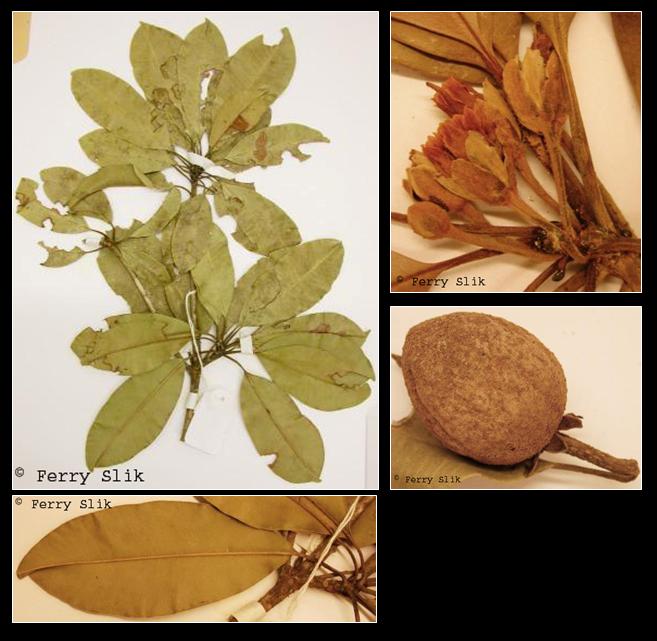Manilkara zapota (L.) P.Royen, Blumea 7 (1953)
Latin for 'cochit-zapotl', the Mexican local name of this species.Synonyms
Achradelpha mammosa (L.) O.F.Cook
Achras breviloba (Gilly) Lundell
Achras calderonii (Gilly) Lundell
Achras conzattii (Gilly) Lundell
Achras coriacea Lundell
Achras cosaguico La Llave
Achras dactylina Lundell
Achras gaumeri (Gilly) Lundell
Achras latiloba Lundell
Achras lobulata (Lundell) Lundell
Achras lucuma Blanco
Achras mammosa L. [Illegitimate]
Achras meridionalis (Gilly) Lundell
Achras occidentalis Cels ex Ten.
Achras paludosa Lundell
Achras petenensis (Lundell) Lundell
Achras rojasii (Gilly) Lundell
Achras sapatilla J.Paul & W.Arnold
Achras sapota L. [Spelling variant]
Achras sapota forma asperma M.G¨Žmez
Achras sapota var. candollei Pierre
Achras sapota var. globosa Stokes
Achras sapota var. lobata (A.DC.) Pierre
Achras sapota var. ovalis Stokes
Achras sapota var. pedicellaris Pierre
Achras sapota var. sphaerica (A.DC.) Pierre
Achras striata (Gilly) Lundell
Achras tabogaensis (Gilly) Lundell
Achras tainteriana Lundell
Achras tchicomame Perr.
Achras verrucosa Stokes
Achras zapota L.
Achras zapota var. major Jacq.
Achras zapota var. zapotilla Jacq.
Achras zapotilla (Jacq.) Nutt.
Calocarpum mammosum (L.) Pierre
Calospermum mammosum (L.) Pierre
Gambeya mammosa (L.) Pierre
Lucuma mammosa (L.) C.F.Gaertn.
Lucuma zapota (L.) Urb.
Lucuma zapota var. anguai Rojas Acosta
Manilkara achras (Mill.) Fosberg
Manilkara breviloba Gilly
Manilkara calderonii Gilly
Manilkara conzattii Gilly
Manilkara gaumeri Gilly
Manilkara grisebachii (Pierre) Dubard
Manilkara meridionalis Gilly
Manilkara meridionalis var. caribbensis Gilly
Manilkara rojasii Gilly
Manilkara sapota (L.) Van Royen
Manilkara striata Gilly
Manilkara tabogaensis Gilly
Manilkara zapotilla (Jacq.) Gilly
Manilkariopsis lobulata Lundell
Manilkariopsis meridionalis (Gilly) Lundell
Manilkariopsis petenensis Lundell
Manilkariopsis rojasii (Gilly) Lundell
Manilkariopsis striata (Gilly) Lundell
Manilkariopsis tabogaensis (Gilly) Lundell
Mimusops grisebachii Pierre
Nispero achras (Mill.) Aubrev.
Pouteria mammosa (L.) Cronquist
Sapota achras Mill.
Sapota achras var. lobata A.DC.
Sapota achras var. sphaerica A.DC.
Sapota zapotilla (Jacq.) Coville ex Safford
Vitellaria mammosa (L.) Radlk.
Description
Evergreen, upright to spreading tree, 5-20(-30)m tall, all parts rich in white gummy latex; trunk low-branched, bark rough, dark-brown,
crown globose or pyramidal, conforming to Aubreville's architectural model. Leaves alternate, ovate-elliptic to oblong-lanceolate, 3.5-15 cm
x 1.5-7 cm, cuneate or obtusely acuminate at both ends, frequently emarginate, entire, glabrescent, glossy dark green, midrib prominent below,
lateral nerves numerous, parallel; petiole 1-3.5 cm long. Flowers solitary in upper leaf axils, usually pendulous, up to 1.5 cm in diameter,
brown-hairy outside; pedicel 1-2 cm long; calyx deeply 6-parted, usually in two whorls, densely grey or brown tomentose outside; corolla white,
campanulate, 6 lobes about half as long as the tube; staminodes 6, petaloid; stamens 6; ovary 10-12-celled, villous; style subulate, exserted
from the flower. Fruit a pendulous berry, globose, ovoid or ellipsoid, 3-8 cm x 3-6 cm, rounded or impressed at base, apex rounded and crowned
by the remnants of the style; skin thin, dull reddish to yellow-brown, covered with a sandy brown scurf; flesh juicy, soft, yellow to red-brown,
sweet. Seeds 0-6(-12), oblong, 2 cm long, brown or black, compressed laterally, hilum distinct. [From PROSEA]
Ecology
Sapodilla is a very adaptable species. It thrives in the tropics, but is found in large numbers at elevations up to 2500 m in Ecuador and also
in the subtropics (Israel); mature trees are not greatly damaged by a few degrees of frost. Sapodilla is very drought-resistant, doing well in
the taxing monsoon climates of India. With its tough branches the tree tolerates strong winds and salt sprays close to the seashore. However,
growth and fruit quality are impaired in extreme environments; the tree thrives in warm, moist tropical lowlands, usually below 600 m in South-East
Asia. The best soil for sapodilla is a rich, well drained, sandy loam, but few soils are unsuitable and sapodilla comes second after the date palm
in the category of fruit trees with high tolerance of saline soils.
Uses
Sapodilla is grown mainly for its fruit which is predominantly eaten fresh. The fruits may also be used in sherbets or ice cream or made into
preserve, butter or jam. The juice may be boiled into syrup or fermented into wine or vinegar. Wild and cultivated trees in America are tapped
for their milky latex which coagulates into chicle, the principal constituent of chewing gum before the advent of synthetics. This gum is also
used in the manufacture of transmission belts, in dental surgery, and as a substitute for gutta percha, a coagulum of the latex of Palaquium spp.,
also in the Sapotaceae, which had many applications in industry before the advent of plastics. The wood is an excellent material for making
cabinets and furniture. The seeds are antipyretic. In Indonesia the flowers are used as one of the ingredients in preparing a powder which is
rubbed on the body of a woman after childbirth. The tannin from the bark is used to tan ship sails and fishing tackle; in Cambodia the tannin
is used to cure diarrhoea and fever.
Distribution
Sapodilla is a native of Central America, Mexico and the West Indies. It is now cultivated to a greater or lesser extent in the tropical
lowlands of both hemispheres. It is an important fruit all over South-East Asia.
Local names
Cambodia: lomut.
English: Sapodilla, naseberry.
French: Sapotillier.
Indonesia: sawo manila, ciku (Sundanese), sawo londo (Java).
Laos: lamud.
Malaysia: ciku.
Philippines: chico.
Thailand: lamut, lamut-farang.
Vietnam: xaboche, hong xiem, ta lu'c.
